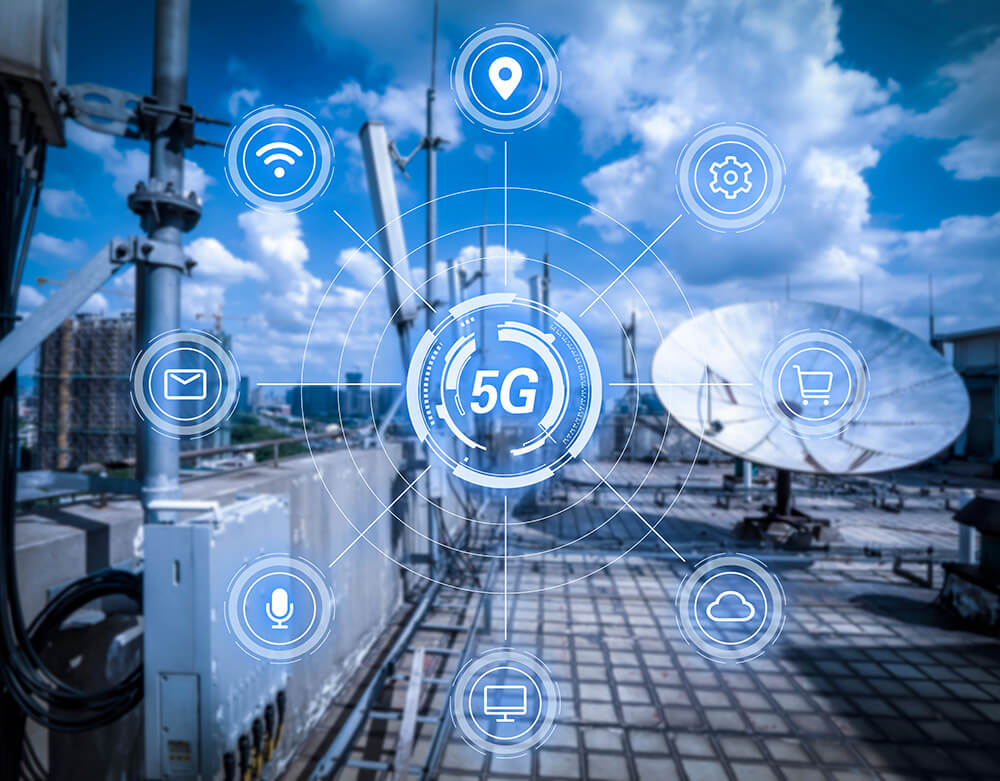Due to the growing number of electronic devices in our environment, radiation exposure from low-frequency and high-frequency fields is also steadily increasing. If you want to find out how much your health is affected by electrical and magnetic fields as well as electromagnetic radiation, you cannot avoid an electrosmog measurement. In this article you will learn how to measure electrosmog yourself and what you have to pay attention to during your measurement.
What is electrosmog?
Electrosmog (also: E-smog) is the term for the daily exposure to technically generated magnetic and electric fields and electromagnetic radiation in our environment. Electrosmog can be measured wherever electricity flows and voltage is generated or radio signals such as WLAN, mobile radio or radio waves are used.
Normally, the term "smog" refers to a visible pollutant in the air. Electrosmog, on the other hand, is an invisible pollution that humans can hardly perceive with their senses.
In order to make electrosmog visible, appropriate devices are therefore required. Since different physical phenomena are involved, a distinction must be made between low-frequency electric fields and high-frequency electromagnetic fields (EMF) when measuring electrosmog.

Why does it make sense to measure electrosmog?
According to the Federal Office for Radiation Protection, almost 2 percent of the population describe themselves as electrosensitive. Electrosensitive (ES) and electrohypersensitive (EHS) often exhibit symptoms such as headaches, sleep disorders, dizziness or tinnitus in the presence of electrical or electromagnetic radiation, which can contribute to a considerable reduction in quality of life.
Affected persons usually develop considerable suffering, which can lead to a reduction in quality of life. In addition, there are other secondary disorders such as frustration, depression and anxiety, which negatively affect the lives of electrosensitive people.
So there is every reason to take ES and EHS (also called EMF syndrome or radio allergy) seriously and to continue the discussion about the harmfulness of electrosmog.
With which measuring device can I measure electrosmog?
There are two different types of devices available for measuring electrosmog: Low frequency measuring devices and high frequency measuring devices.
Low frequency measuring devices
Low-frequency meters are suitable for measuring low-frequency electric and magnetic fields emitted by power lines in the house and by the electrical devices connected to them. Particularly critical in this context are the magnetic fields that are generated whenever a device is switched on and current flows. The low-frequency electric field from power lines is less dangerous, but it is present around the clock unless the power has been completely shut off or disconnected by a demand switch. Instruments for measuring low-frequency fields can be found in our store under the heading Low-frequency measuring instruments.
High frequency measuring instruments
High-frequency measuring instruments are used wherever a measurement of high-frequency electromagnetic fields is required. High-frequency radiation is emitted, for example, by devices such as WLAN routers, DECT cordless phones, smartphones and microwave ovens and uses the frequency range from a few megahertz up to the gigahertz range. The high frequencies are not bound to a local conductor, as are the low frequencies. The high-frequency radiation radiates far in all directions and can, for example, penetrate from the neighboring apartment into one's own living area. You can find measuring instruments for measuring high-frequency electromagnetic fields in our store under the heading High-frequency measuring instruments.
How does an electrosmog measurement work? A step-by-step guide
If you want to measure electrosmog, first of all choose the appropriate device. If you are not sure which device to choose, we are always at your disposal. For reliable readings you should not use cheap combination devices, as they are offered in some construction and electronics markets, because they cannot provide meaningful readings due to their design.
1. Preparation
Almost all Gigahertz Solutions measuring instruments are delivered in a shockproof plastic case. This ensures that the high-quality technology can be stored and transported safely. Before you start measuring electrosmog, the antenna must first be plugged in when using a high-frequency measuring device (not necessary with low-frequency measuring devices). Antenna and antenna cable must not be bent and should be handled with care overall. Once the antenna is plugged in and the instrument is switched on, you can start the measurement.

2. Measuring high-frequency electrosmog (with a HF analyzer)
Depending on which of our meters you use to measure high-frequency electrosmog, you have different possible functions with the meters. With the function measuring range ("Range") you set the measuring range, always starting with the largest range. Depending on whether you want to measure the complete signal or only the pulsed part, please select the setting "Full" or "Pulse". With the function "Signal" you determine either the average value RMS or the highest peak. Building biology always considers the peak value ("Peak") in measurements, so this is also our standard setting.
The measurement itself is done with a sweeping hand movement in the form of a lying figure eight, since high-frequency electromagnetic radiation is polarized either vertically or horizontally. Our meters and antennas are set to automatically measure the vertical radiation when the display is parallel to the ground. To measure the horizontal portion as well, you need to swivel the meter 90° at regular intervals. In this way, you then traverse the entire living area to first determine the regions most exposed to electrosmog.
If you want to compare the measured values with your guideline value table, always select the highest value measured in a room. If you want to know which high-frequency radiation is currently predominant, you are welcome to use the volume control of the audio analysis of the measuring device. On our homepage we have published the acoustic patterns of many radio services for comparison.
3. Measuring low-frequency electrosmog (with a LF analyzer)
As already mentioned, you do not need any external antennas for our low-frequency analyzers. You can start measuring immediately. Set the selector switch to "M" to measure magnetic flux density or to "E" to measure electric field strength. There are two possibilities for measuring the electric field strength. Grounding the meter is recommended for finding sources of electric alternating fields. Regular measurements are also possible without grounding the meter. For an E-field measurement, hold the meter as close to your body as possible and then move through the desired room. Swing the meter in all directions. Measure especially in places where you spend a long time in everyday life (e.g. bedroom, study, etc.).
For the measurement of alternating magnetic fields, set the selector switch to position "M". Grounding or carrying the device close to the body is not necessary when measuring the magnetic flux density. Now examine the desired room and hold the measuring instrument to the source of radiation as described in more detail in our operating instructions.
4. Finding the source
Once you have detected contaminated areas in your house, the next step is to precisely locate the source of the radiation. By switching off the power at your fuse box or switching off WLAN routers, for example, you can usually determine the source directly. If the radiation levels are still too high afterwards, the cause lies outside your living area. Examples could be regional transmitting antennas, nearby high-voltage lines or the neighbor's WLAN. If you do not see any possibility to eliminate the external source of radiation, we will be happy to help you with our shielding products or a professional electrosmog remediation.
Which limit values apply to an electrosmog measurement?
Unfortunately, nowadays legislation has exclusively used the thermal effect of electrical and electromagnetic radiation for the determination of limit values, which is due to the fact that this is particularly easy to measure. The legislation assumes that a danger to humans only exists when a body part is heated by more than 1°C.
For many doctors, building biologists and scientists, the legal limits do not go far enough. Instead, many of them follow the "standard of building biology measurement technology". Here are some examples of their guide values for electric, magnetic and electromagnetic fields (radiation density in microwatts per square meter (µW/m²)):
Evalution Guideline according to the standard of building biology measurement technology:

High Frequency
-
- 0,1-10 µW/m² = Slight
- 10-1000 µW/m² = Severe
- > 1000 µW/m² = Extreme
Low Frequency
-
- 20-100 nT = Slight
- 100-500 nT = Severe
- > 500 nT = Extreme
Tab. 1: Building biology guide values for high-frequency and low-frequency fields
Conclusion: Measuring electrosmog - can also be done by yourself!
Whether WLAN, mobile radio, cell phone or microwave: There is more radiation in our environment than ever before. Never before in our evolution have we been exposed to such a barrage of electric and magnetic fields and electromagnetic radiation. If you want to protect yourself or know which radiation you are currently affected by, there are a number of high-quality products available for shielding and for measuring high-frequency and low-frequency fields.
Do you have any questions or would you like more information about our products? We will be happy to help you at any time with words and deeds.

Do you need help?
We will be glad to help you.
We will be happy to assist you in selecting the appropriate measuring device and also advise you on possible protection solutions.
Just contact us!
Mo-Thu 08:00 am – 5:00 pm / Fr 08:00 am – 1:00 pm
Phone: 0049 9101 / 90 93 - 0
Email: info@gigahertz-solutions.de


